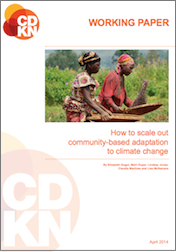How to scale out community-based adaptation to climate change


Summary
The impacts of climate change are context specific and the resources and capacity available for adaptation are locally defined. As a result, adaptation activities must be localised. However, there will be similarities in terms of climate change impacts and adaptation capacity across a wider area, so there is still potential for scaling out CBA solutions to other areas. CBA pilots can test adaptation options that are suitable to a particular local area or even country, thus potentially benefiting a group much larger than the immediate community.A new CDKN Working Paper authored by CDKN staff from across the alliance – Elizabeth Gogoi, Mairi Dupar, Lindsey Jones, Claudia Martinez, and Lisa McNamara – explores the ‘scaling out’ of CBA pilots, which is defined as bringing ‘more quality benefits to more people over a wider geographical area, more equitably, more quickly, and more lastingly’. Rather than higher-level policy integration, it focuses on how multiple local actors can pilot small-scale innovations and showcase them until their approaches are replicated by multiple local actors, and a particular technology, practice or local regulatory approach becomes widespread.The working paper identifies several key elements that are common to successful cases of scaling out. Learning from CDKN’s work in Bangladesh, Colombia and eastern and southern Africa, it provides insights into the role of:
- networks and partnerships
- documenting evidence and learning
- adaptive capacity
- institutional channels and finance mechanisms
Suggested citation
Gogoi, E., Dupar, M., Jones, L., Martinez, C., McNamara, L. 2014. How to scale out community-based adaptation to climate change. CDKN Working Paper.
(0) Comments
There is no content